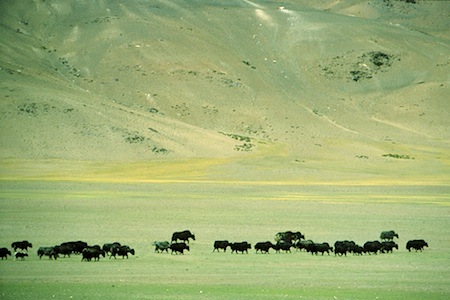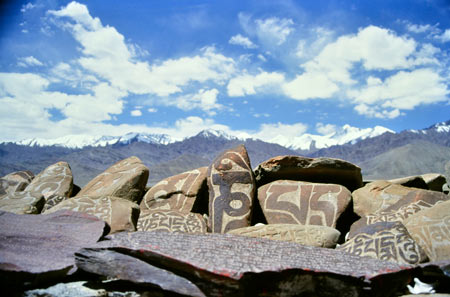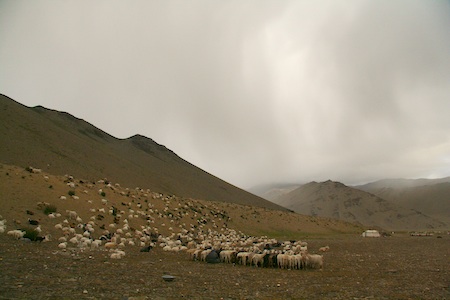Western Tibet

Shang Shung civilization
Vast prairies punctuated with snow-covered peaks, farming valleys with irrigated cultures alternating with moonlike landscapes of sand and rocks, all of this ornated with splendid lakes with turquoise waters : the tibetan West is is an enchanted land, whose ultimate jewel is Mount Kailash, elegant silouhette the aura of which radiates way beyond Tibet.
Called the "Roof of the Roof of the World", this majestic territory has been for centuries the home of a still little known civilization : Shang Shung. It came out during the first millenium BC, structuring itself out of the scattered societies which populated the region during the Iron Age. While the population kept living of hunting, nomadic shepherding and altitude farming, a warlike artistocracy grew up, until it reigned over a territory as large as present-day Bolivia, covering the west and the north of Tibet, which was then wetter and warmer than now. Citadels were built throughout the territory, displaying a unified cultural style. These barren stone fortresses were decorated with paintings depicting the life of the people of Shang Shung, especially scenes of hunting and shepherding, and revealing a culture that emphasized horse and war, a common pattern among the civilizations of Central Asia.
Highest civilization in the world, Shang Shung suffered from this geographical feature with the region going slowly colder, which gradually impoverished it in resources and capacity. Weakened, the kingdom could only trigger the apetite of the neighbouring state, a dynamic monarchy based in Central Tibet which was about to become one of the great powers of ancient Asia. Shang SHung was incorporated into theTibetan empire in the 7th century and kept loosing its internal dynamism until its last breath in the tenth century.

The Three Circles Of Ngari
The Central Tibetan empire initiated by Songtsen Gampo didn’t last long. After its collapse in the ninth century, a dissident branch of the royal family escaped to Western Tibet, where they organized a new state : Ngari Kor Sum, the Three Circles of Ngari. These three Circles were Purang in the south, Guge in the center and Rutok in the north – the latter including Ladakh, then known as Maryul, the Red Land.
These political vicissitudes had little influence on local populations, for most of them rural and scattered over vast territories. A notable contribution took place in the XIth century with the expansion of a new religion : buddhism.
Ngari remained independent for several centuries. In the meantime, mongol warlords had re-established Central Tibet as an organized state, structured as a clerical monarchy headed by a buddhist monk, the Dalai Lama. The latter was going to become a centralized authority for all tibetan buddhist populations, after the opposition movements were crushed by mongol troops. This new tibetan state reached its geopolitical peak under the the 5th dalai lama, in the seventeeth century.
In 1682, the kingdom of Ngari was attacked by Kashmir. An army was sent by Tibet to liberate its western neighbour. As a consequence, Ngari fell under the suzerainety of the Dalai Lama.

Nowadays
In the second part of XXth century, the brand new People's Republic of China annexed all the territories previously controled by the central power in Lhassa, hence including the Ngari region. Central Tibet and Ngari now constitute he bulk of the Tibetan Autonomous Region.
Throughout centuries, life in Western Tibet has little changed. Farmers kept growing barley around their villages of strong stone houses, nomads discontinously took care of their yaks, goats and sheep which provide them with wool, yoghourt, leather… Women never ceased being fond of ornaments made of turquoise, horse has kept its prestigious aura in the eyes of men, and the habit of singing in any occasion has not been lost, whether it is for taking the sheep to the grazing land, for throwing into the fields the seeds for the next harvest, or for gathering in the evening around a fire to thrill together at the sound of voices telling about life, history and the world…